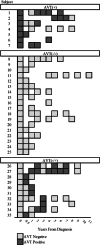Prognostic value of longitudinal vasoreactivity in pediatric pulmonary hypertension
- PMID: 36381291
- PMCID: PMC9638879
- DOI: 10.1002/pul2.12152
Prognostic value of longitudinal vasoreactivity in pediatric pulmonary hypertension
Abstract
Upon diagnosis of pulmonary hypertension in pediatrics, standard practice often involves acute vasoreactivity testing (AVT) in the cardiac catheterization laboratory. However, the importance of repeated AVT testing in a given patient thereafter remains unclear. This study sought to describe serial AVT results in pediatric patients and understand the prognostic significance of longitudinal AVT results in pediatric pulmonary hypertension. A retrospective chart review was performed for pediatric pulmonary hypertension patients diagnosed between 2008 and 2021. Patients were included if they had two or more catheterizations with AVT. The study cohorts were patients who were AVT negative upon initial catheterization then AVT positive at any subsequent catheterization (AVT-/+) compared to those were AVT negative upon initial and all subsequent catheterizations (AVT-/-). A positive AVT was defined by Sitbon criteria. The analyzed outcome was event-free survival. The relationship between study cohorts and event-free survival was analyzed by log-rank Kaplan-Meier survival as well as Cox proportional hazard regression to control for confounders. There were 35 patients who met inclusion criteria in this time period. Patients who were AVT(-/+) had statistically significantly better event-free survival than AVT(-/-) (p = 0.002). In univariate and multivariate Cox regressions, a subsequent AVT positive result amongst those who were initially AVT negative was a positive prognostic factor, hazard ratio 0.03 (95% confidence interval: 0.02-0.35). For patients with negative AVT upon initial cardiac catheterization, this data supports that continuing AVT should be performed as any subsequent AVT positive result may indicate improved expectations for event-free survival.
Keywords: hemodynamics; hypertension; pediatrics; pulmonary.
© 2022 The Authors. Pulmonary Circulation published by John Wiley & Sons Ltd on behalf of Pulmonary Vascular Research Institute.
Conflict of interest statement
The authors declare no conflicts of interest.
Figures




References
-
- Abman SH, Mullen MP, Sleeper LA, Austin ED, Rosenzweig EB, Kinsella JP, Ivy D, Hopper RK, Raj JU, Fineman J, Keller RL, Bates A, Krishnan US, Avitabile CM, Davidson A, Natter MD, Mandl KD. Characterisation of paediatric pulmonary hypertensive vascular disease from the PPHNet registry. Eur Respir J. 2022;59:2003337. - PMC - PubMed
-
- Abman SH, Hansmann G, Archer SL, Ivy DD, Adatia I, Chung WK, Hanna BD, Rosenzweig EB, Raj JU, Cornfield D, Stenmark KR, Steinhorn R, Thébaud B, Fineman JR, Kuehne T, Feinstein JA, Friedberg MK, Earing M, Barst RJ, Keller RL, Kinsella JP, Mullen M, Deterding R, Kulik T, Mallory G, Humpl T, Wessel DL. Pediatric pulmonary hypertension: guidelines from the American Heart Association and American Thoracic Society. Circulation. 2015;132:2037–99. - PubMed
-
- Hansmann G, Koestenberger M, Alastalo T‐P, Apitz C, Austin ED, Bonnet D, Budts W, D'Alto M, Gatzoulis MA, Hasan BS, Kozlik‐Feldmann R, Kumar RK, Lammers AE, Latus H, Michel‐Behnke I, Miera O, Morrell NW, Pieles G, Quandt D, Sallmon H, Schranz D, Tran‐Lundmark K, Tulloh RMR, Warnecke G, Wåhlander H, Weber SC, Zartner P. 2019 updated consensus statement on the diagnosis and treatment of pediatric pulmonary hypertension: the european pediatric pulmonary vascular disease network (EPPVDN), endorsed by AEPC, ESPR and ISHLT. J Heart Lung Transplant. 2019;38:879–901. 10.1016/j.healun.2019.06.022 - DOI - PubMed
-
- Tonelli AR, Alnuaimat H, Mubarak K. Pulmonary vasodilator testing and use of calcium channel blockers in pulmonary arterial hypertension. Respir Med. 2010;104:481–96. - PubMed
-
- Rosenzweig EB, Bates A, Mullen MP, Abman SH, Austin ED, Everett A, Fineman J, Feinstein J, Hopper RK, Kinsella JP, Krishnan US, Lu M, Mandl KD, Raj JU, Varghese N, Yung D, Handler SS, Sleeper LA. Cardiac catheterization and hemodynamics in a multicenter cohort of children with pulmonary hypertension. Ann Am Thorac Soc. 2022;19:1000–12. 10.1513/AnnalsATS.202108-998OC - DOI - PMC - PubMed
LinkOut - more resources
Full Text Sources
Miscellaneous

